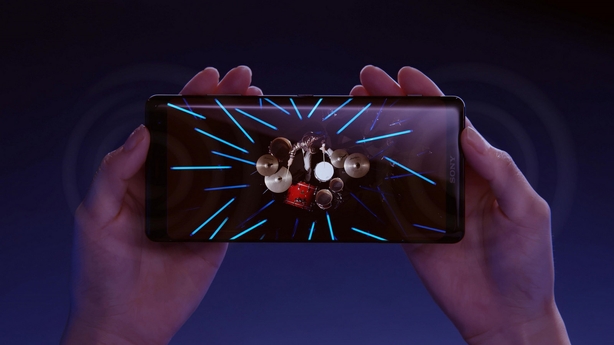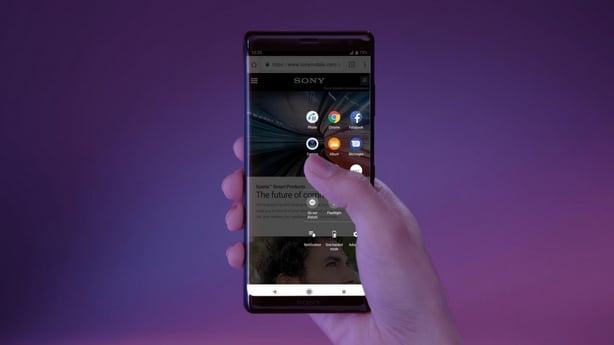Quite why, just six months after it launched its last flagship smartphone, Sony has decided to push out another one, is something of a mystery.
It seems to be related to the company’s strategy of having two premium devices in the range at all times, which one would imagine is based on market research.
Although it still remains difficult to see from a pure logic point of view why it would be a guide idea to release two very similar devices so close together.
But nonetheless, the Xperia XZ3 is now available, supplementing the Xperia XZ2 that was unveiled at Mobile World Congress in February.
So if you are due an upgrade, is the newer device worth a punt?

DESIGN
Sony has made decent strides in freshening up its premium design in recent times, and the XZ3 continues that trend.
The device has a curved edge-to-edge display that gives it a look not dissimilar to the Samsung Galaxy S9.
The screen, once again, isn’t quite completely bezel-less, with a strip at the top of the screen for the phone speaker and camera lens, and at the bottom for the Sony logo.
But it does look the part.
The curved back still has the single lens main camera mounted in the centre line, about a third of the way down.
Below that is the finger print sensor.
I continue to struggle with the placement of finger-print readers in such a location – my long fingers just don’t comfortably reach it.
As a result, I regularly put my fingertip over the camera lens, leading to smudges which isn’t ideal.
The fingerprint sensor itself though, is accurate and fast – so no complaints there.
One design feature I did like is the SIM card and SD card tray, which can be pulled out with a finger nail, rather than needing a pin.
Despite this, the device carries an IP68 water resistance rating.
It isn’t the lightest smartphone in the class, but it is comfortable to hold and use.
It has Gorilla Glass front and back which makes it quite slippery to hold and prone to scratches, although most users will probably put it in a cover anyway so that won’t matter too much.
There’s no 3.5 inch audio jack, but there is a USB-C audio adapter supplied with every handset.
It comes in four colours - Black, White Silver, Forest Green and Bordeaux Red.

DISPLAY
The biggest talking point with the XZ3 is undoubtedly the screen.
Sony has introduced OLED for the first time, putting its BRAVIA TV technology to great use.
The resulting Quad HD display is remarkably good, and places Sony right back at the top of the tree when it comes to screen quality.
It is a little late to the party on this, but its first effort at OLED has made up for any lost ground and then some.
Picture quality is incredibly vibrant and sharp, with an excellent contrast ratio.
Add in the Dynamic Vibration System introduced on the XZ2 and the result is as good an immersive experience as you’ll find on a 6" display or similar.
The screen also features Sony’s X-Reality upscaler that converts TV programmes and films to close to High Dynamic Range.
CAMERA
If the display on the XZ3 represents a step forward, the camera hardware has stood still.
It’s the same 19MP Motion Eye camera sensor found on the XZ2 and XZ1.
That’s something of a disappointment as all the other big manufacturers have moved to double or triple lens camera systems.
It is a deficiency that Sony will no doubt fix in the next instalment of the XZ range.
But in the meantime what it has done is make the implementation of the existing hardware better.
For starters, the user interface has changed making it easier to navigate and use.
And while there isn’t a huge amount new in terms of features, everything is now just a tap or two away rather than buried down a rabbit warren of menus.
There’s also a Smart Launch feature, which automatically fires up the camera mode from sleep mode when the device is lifted up into landscape mode.
The hard camera button is also there on the side of the device to achieve the same aim.
The quality of the images has improved a little too, although it still struggles at times in low light.
When it comes to selfie-mode the XZ3 has also received a boost – there’s now a 13MP sensor on the front which offers a Portrait Selfie mode with a Bokeh effect, eye enlargement and other editing gizmos.
While the device can also record 4K HDR video, which is a positive.
HARDWARE
One other sign of just how little time there was between the release of the XZ2 and the XZ3 is that both use the same Qualcom Snapdragon 845 processor.
That, couple with the 4GB of RAM provided does provide plenty of power though.
We’ve seen no lag, hanging or other hiccups, with easy and quick multi-tasking.
There’s a reasonable level of on-board storage too, with 64GB built in, although many manufacturers are now offering more generous basic storage.
But capacity can of course be expanded by a further 512GB of SD card memory.
The 3330 mAh battery, combined with the processor, is plenty big enough for an average day’s use.
The device also supports fast and wireless charging, with the usual features available to reduce power consumption if the levels are getting extremely low.
In the sound department the XZ3 has stereo speakers with S-Force Front Surround sound which pump out more volume than its predecessor.
High-Res audio is still there and wireless sound through headphones is impressive.

OTHER FEATURES
As phones get bigger, it is becoming increasingly tricky to use them one-handed.
To address this, Sony has taken a leaf from Samsung’s book, introducing Side Sense – an overlaid control panel that provides quick access to regularly used apps.
A double tap on the side of the screen (left or right) will cause the tray to open. You then select your app, or swipe along the edge to make it disappear.
It’s a useful enough idea, but the execution isn’t fantastic. I found it temperamental to use and with a cover it is likely going to be even trickier.
The phone comes with the latest version of Android on it – 9 or Pie- and Sony’s own overlaid skin interface is easy to navigate and pleasant to look at.
One issue though is that the device comes with too much bloatware.
CONCLUSION
If you put aside the question of why release another flagship so soon, and look purely at the device itself, there is much to like about the XZ3, which is without doubt Sony’s best effort yet.
It has an excellent new screen, the camera isn’t bad for a single lens model, it looks good and its credentials in the audio department are strong.
But Sony really hasn’t done enough to differentiate this device from what went before it.
The company is falling behind on camera specs and there are other niggles too like the positioning of the fingerprint sensor and implementation of the Side Sense feature which detract from the overall experience.
It is likely that we’ll have to wait longer for the next upgrade of this device.
But that’s no harm at all. Sony would be advised to take that time to ensure its next step forward is an even bigger one, particularly when it comes to camera tech and security features.
And if it gets that right, then there’s every chance the next Xperia flagship could be a market leader.
Comments welcome via Twitter to @willgoodbody







